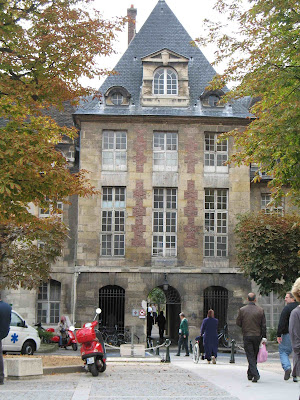 Once again on the trail of Paris' musées insolites in the medical sphere, we (myself, my wife Christine, and Joanna Ebenstein, of Morbid Anatomy fame) headed to the hôpital Saint-Louis to see the collection of moulages secreted within. It actually lies outside the main 17th century building in a structure dating to 1899. To gain entrance to the Musée you must first seek out the cashier’s office in the hôpital Saint-Louis, and pay the admission fee. Then retrace your steps to the Musée and present the voucher Just follow the signs in the hospital complex grounds.
Once again on the trail of Paris' musées insolites in the medical sphere, we (myself, my wife Christine, and Joanna Ebenstein, of Morbid Anatomy fame) headed to the hôpital Saint-Louis to see the collection of moulages secreted within. It actually lies outside the main 17th century building in a structure dating to 1899. To gain entrance to the Musée you must first seek out the cashier’s office in the hôpital Saint-Louis, and pay the admission fee. Then retrace your steps to the Musée and present the voucher Just follow the signs in the hospital complex grounds.

Original 17th century hospital buildings
Musée des moulages de l'hôpital Saint-Louis 1 avenue Claude-Vellefaux 75475 Paris

 Chief among moulage collections depicting the ravages of disease in wax is the Musée des moulages de l'hôpital Saint-Louis, featuring almost 2500 dermatological moulages. Mme. Françoise Durand, conservateur of the Musée des moulages (with the portrait of Pierre François Baretta, master of moulage), graciously greeted us and presented the history of the collection .
Chief among moulage collections depicting the ravages of disease in wax is the Musée des moulages de l'hôpital Saint-Louis, featuring almost 2500 dermatological moulages. Mme. Françoise Durand, conservateur of the Musée des moulages (with the portrait of Pierre François Baretta, master of moulage), graciously greeted us and presented the history of the collection .
The place has a somewhat dark, even forlorn air about it, perhaps exacerbated by ceiling/roofing problems crying for proper repair. To some visitors, the verisimilitude of the moulages might be off-putting; I’ve gotten used to that, having seen similar collections in London, Zurich, Vienna, and Leiden. Others will find the moulages absolutely captivating, from both clinical and artistic standpoints.
 However, I’ve always felt that moulage collections called out for better interpretation, to provide context and meaning. Who commissioned these moulages, who made them (and how), and who used them, and how? Such questions were of course addressed by Thomas Schnalke, today of the Charité’s Berliner Medizinhistorisches Museum, in his classic, Diseases in Wax: the History of Medical Moulage (1995). Interest in and analyses of moulages continues unabated, as evidenced by recent conferences in Edinburgh, Leiden, and Dresden, -- but that scholarship hasn’t yet figured into the interpretation at the Musée des moulages.
However, I’ve always felt that moulage collections called out for better interpretation, to provide context and meaning. Who commissioned these moulages, who made them (and how), and who used them, and how? Such questions were of course addressed by Thomas Schnalke, today of the Charité’s Berliner Medizinhistorisches Museum, in his classic, Diseases in Wax: the History of Medical Moulage (1995). Interest in and analyses of moulages continues unabated, as evidenced by recent conferences in Edinburgh, Leiden, and Dresden, -- but that scholarship hasn’t yet figured into the interpretation at the Musée des moulages.

In my next post on the Musée, I will focus in on one scholar’s take on the museum’s collection, and how it made me see the moulages in a completely new light.
Jim Edmonson

No comments:
Post a Comment